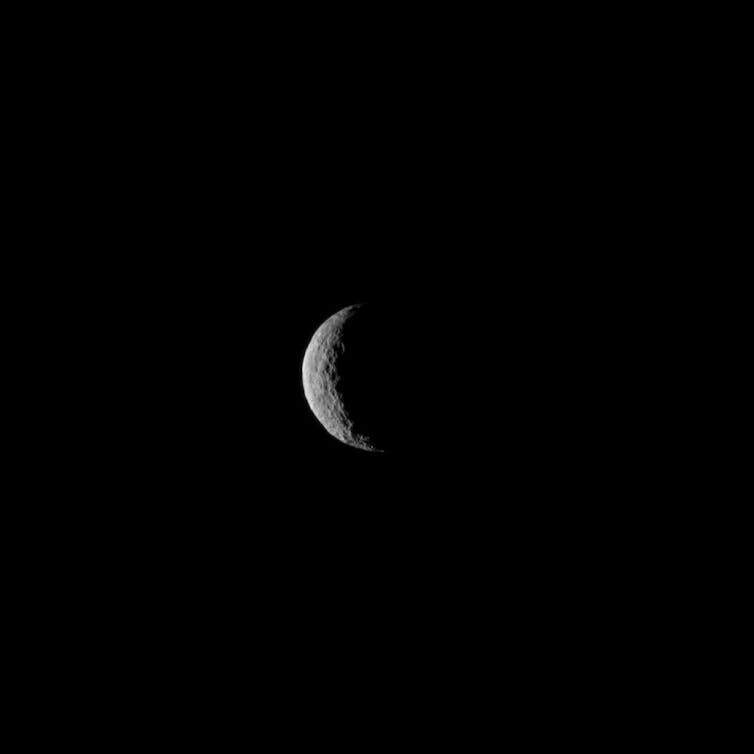Science
Curious Kids: Why does it matter if Pluto is a planet or a dwarf planet? – The Conversation


Curious Kids is a series for children of all ages. Have a question you’d like an expert to answer? Send it to CuriousKidsCanada@theconversation.com.
Why does it matter if Pluto is a planet or a dwarf planet? Because for me it just makes it more confusing in our solar system. I know that some things in space are planets and some are stars and some are other names like moons or comets. Dwarf planet is a more different name and I think it just makes it more confusing. —
Timmy, 11, Kitchener, Ont.
“Comet,” “star” and “planet” are category names that immediately tell you something important about what they describe.
Our solar system consists of the sun, planets (which orbit around the sun) and small bodies (which either orbit around the sun or planets). The “small bodies” category is divided up into even smaller categories, mostly depending on the shape and size of orbits.
Read more:
What is a dwarf planet?
In 1801, astronomers discovered Ceres, which was initially categorized as a “planet.” Astronomers measured that it was much smaller than the other known planets. Soon, a lot of smaller objects were discovered on orbits very close to Ceres. These small bodies were categorized as “asteroids” and we have since discovered hundreds of thousands of these in the asteroid belt.

(NASA/JPL-Caltech/UCLA/MPS/DLR/IDA)
New discoveries
A similar process of discovery and re-categorization happened for small bodies further out in the solar system.
Pluto was discovered in 1930 and was called the ninth planet in our solar system for many decades. But astronomers soon learned that Pluto was pretty different from the other eight planets: it’s on a tilted orbit and it’s way, way smaller than the other planets.
Over the years, astronomers discovered more and more small, planet-like objects that crossed Pluto’s orbit. These are now categorized as “Kuiper Belt objects.” It was looking more and more like Pluto might fit in better with the category of Kuiper Belt objects than with planets.
Read more:
How we discovered 840 minor planets beyond Neptune – and what they can tell us
In 2005, a new object was discovered in the outer solar system, Eris, that is even heavier than Pluto. This led astronomers to consider if both Eris and Pluto are planets or not. Astronomers thought this was an important enough decision that the International Astronomical Union voted on it in 2006. Astronomers decided that rather than demoting Pluto to a plain old Kuiper Belt object, they would make a new category of small body called a “dwarf planet.” Pluto and Eris would both be part of this new category.
How planets form
Solar systems like ours form from big clouds of dust and gas that collapse into disks around young stars, but astronomers are still learning exactly how that process works. We use telescopes to look carefully at forming solar systems far away, but they are so far that it’s really hard to see the planets forming directly.
A planetesimal — a baby planet — first forms from clumps of dust in a disc orbiting a young star. Planetesimals then grab nearby pebbles, dust and sometimes even smaller planetesimals with their gravity, which gets stronger as they get bigger. When they get to be a few hundred kilometres across, they have enough gravity to pull themselves into a round shape, which is the definition of a dwarf planet.

(NASA/ESA, R. Soummer, Ann Feild (STScI))
Measuring small bodies in our solar system, including dwarf planets, and comparing them with computer simulations is another way to see how our solar system formed. Our current theory is that there must have been a lot of dwarf planets that formed in our solar system.
Ceres, in the asteroid belt, and Pluto, Eris and about a dozen other Kuiper Belt objects are big enough to be in the dwarf planet category. This means that while they are planetesimals that grew big enough to be round, they did not develop a gravity strong enough to grab all the other planetesimals near their orbit.
Other solar systems
Astronomers have now measured more than 5,000 exoplanets, planets in other solar systems. We won’t be able to measure dwarf planets there for a very long time, but the ones we’ve found in our own solar system can teach us about how planets form everywhere.
Hello, curious kids! Do you have a question you’d like an expert to answer? Ask an adult to send your question to CuriousKidsCanada@theconversation.com. Please tell us your name, age and the city where you live.
And since curiosity has no age limit — adults, let us know what you’re wondering, too. We won’t be able to answer every question, but we will do our best.
Science
Giant prehistoric salmon had tusk-like teeth for defence, building nests


|
|
The artwork and publicity materials showcasing a giant salmon that lived five million years ago were ready to go to promote a new exhibit, when the discovery of two fossilized skulls immediately changed what researchers knew about the fish.
Initial fossil discoveries of the 2.7-metre-long salmon in Oregon in the 1970s were incomplete and had led researchers to mistakenly suggest the fish had fang-like teeth.
It was dubbed the “sabre-toothed salmon” and became a kind of mascot for the Museum of Natural and Cultural History at the University of Oregon, says researcher Edward Davis.
But then came discovery of two skulls in 2014.
Davis, a member of the team that found the skulls, says it wasn’t until they got back to the lab that he realized the significance of the discovery that has led to the renaming of the fish in a new, peer-reviewed study.
“There were these two skulls staring at me with sideways teeth,” says Davis, an associate professor in the department of earth sciences at the university.
In that position, the tusk-like teeth could not have been used for biting, he says.
“That was definitely a surprising moment,” says Davis, who serves as director of the Condon Fossil Collection at the university’s Museum of Natural and Cultural History.
“I realized that all of the artwork and all of the publicity materials and bumper stickers and buttons and T-shirts we had just made two months prior, for the new exhibit, were all out of date,” he says with a laugh.
Davis is co-author of the new study in the journal PLOS One, which renames the giant fish the “spike-toothed salmon.”
It says the salmon used the tusk-like spikes for building nests to spawn, and as defence mechanisms against predators and other salmon.
The salmon lived about five million years ago at a time when Earth was transitioning from warmer to relatively cooler conditions, Davis says.
It’s hard to know exactly why the relatives of today’s sockeye went extinct, but Davis says the cooler conditions would have affected the productivity of the Pacific Ocean and the amount of rain feeding rivers that served as their spawning areas.
Another co-author, Brian Sidlauskas, says a fish the size of the spike-toothed salmon must have been targeted by predators such as killer whales or sharks.
“I like to think … it’s almost like a sledgehammer, these salmon swinging their head back and forth in order to fend off things that might want to feast on them,” he says.
Sidlauskas says analysis by the lead author of the paper, Kerin Claeson, found both male and female salmon had the “multi-functional” spike-tooth feature.
“That’s part of our reason for hypothesizing that this tooth is multi-functional … It could easily be for digging out nests,” he says.
“Think about how big the (nest) would have to be for an animal of this size, and then carving it out in what’s probably pretty shallow water; and so having an extra digging tool attached to your head could be really useful.”
Sidlauskas says the giant salmon help researchers understand the boundaries of what’s possible with the evolution of salmon, but they also capture the human imagination and a sense of wonder about what’s possible on Earth.
“I think it helps us value a little more what we do still have, or I hope that it does. That animal is no longer with us, but it is a product of the same biosphere that sustains us.”
This report by The Canadian Press was first published April 24, 2024.
Brenna Owen, The Canadian Press





Science
Giant prehistoric salmon had tusk-like spikes used for defence, building nests: study


|
|
A new paper says a giant salmon that lived five million years ago in the coastal waters of the Pacific Northwest used tusk-like spikes as defense mechanisms and for building nests to spawn.
The initial fossil discoveries of the 2.7-metre-long salmon in Oregon in the 1970s were incomplete and led researchers to suggest the fish had fang-like teeth.
The now-extinct fish was dubbed the “saber-tooth salmon,” but the study published in the peer-reviewed journal PLOS One today renames it the “spike-toothed salmon” and says both males and females possessed the “multifunctional” feature.
Study co-author Edward Davis says the revelation about the tusk-like teeth came after the discovery of fossilized skulls at a site in Oregon in 2014.
Davis, an associate professor in the department of earth sciences at the University of Oregon, says he was surprised to see the skulls had “sideways teeth.”
Contrary to the belief since the 1970s, he says the teeth couldn’t have been used for any kind of biting.
“That was definitely a surprising moment,” Davis says of the fossil discovery in 2014. “I realized that all of the artwork and all of the publicity materials … we had just made two months prior, for the new exhibit, were all out of date.”





Science
SpaceX sends 23 Starlink satellites into low-Earth orbit


|
|
April 23 (UPI) — SpaceX launched 23 Starlink satellites into low-Earth orbit Tuesday evening from Space Launch Complex 40 at Cape Canaveral Space Force Station in Florida.
Liftoff occurred at 6:17 EDT with a SpaceX Falcon 9 rocket sending the payload of 23 Starlink satellites into orbit.
The Falcon 9 rocket’s first-stage booster landed on an autonomous drone ship in the Atlantic Ocean after separating from the rocket’s second stage and its payload.
The entire mission was scheduled to take about an hour and 5 minutes to complete from launch to satellite deployment.
The mission was the ninth flight for the first-stage booster that previously completed five Starlink satellite-deployment missions and three other missions.





-



 Health21 hours ago
Health21 hours agoRemnants of bird flu virus found in pasteurized milk, FDA says
-
News18 hours ago
Amid concerns over ‘collateral damage’ Trudeau, Freeland defend capital gains tax change
-
Art21 hours ago
Random: We’re In Awe of Metaphor: ReFantazio’s Box Art
-
Art15 hours ago
The unmissable events taking place during London’s Digital Art Week
-



 Politics19 hours ago
Politics19 hours agoHow Michael Cohen and Trump went from friends to foes
-
Tech22 hours ago
Surprise Apple Event Hints at First New iPads in Years
-
Science20 hours ago
NASA hears from Voyager 1, the most distant spacecraft from Earth, after months of quiet
-
Media21 hours ago
Vaughn Palmer: B.C. premier gives social media giants another chance





